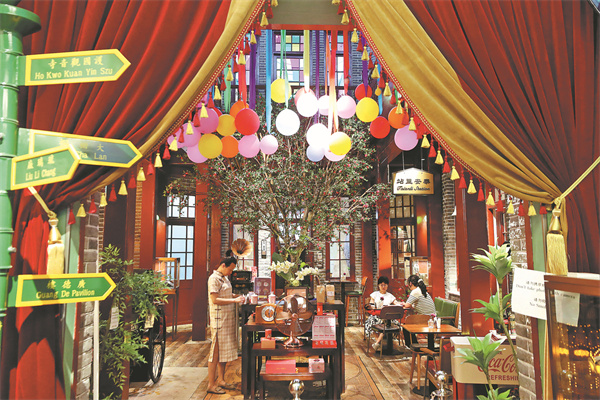New life infused into Beijing's past

Visitors relax in an artistic space at the Tai'an Li Cultural and Arts Center in Xicheng district, Beijing, last month. WANG JING/CHINA DAILY
Shanghai-styled compound now home to thriving businesses
For the past 50 years, Chen Shiguo, a 71-year-old Beijing native, has lived close to the distinctive Tai'an Li compound, which houses six two-story shikumen houses in the city's Xicheng district.
Shikumen, which translates as "stone warehouse gate", is an architectural style from Shanghai that mixes Chinese and Western elements. Shikumen houses were built in that city from the 1860s to 1930s, usually for families belonging to the middle-income group.
Built in 1914, Tai'an Li is the only preserved shikumen structure in the Chinese capital.
Located off Zhushikou West Street along the meandering hutong, or alleyways, leading to Zhushikou subway station, Tai'an Li was the first cultural heritage site in Xicheng to undergo adaptive reuse in April 2018, after 89 families living in the six buildings were relocated.
The local government has restored the buildings to their former glory. After five years of renovation work, the ancient compound, which was part of Xiangchang New District — a pilot area for revitalizing Beijing from 1914 to 1918 — reopened to the public. It is now a venue for cafes, live action role-playing games, restaurants serving traditional cuisine, and the city's first feminist-themed bookstore.
Chen was invited to revisit the compound after it reopened. "Returning there reminded me of the old days when I watched juggling and magic tricks being performed in front of the buildings," he said.
He added that it was easy to convert the ground floor units in the compound into small shops to bring landlords increased rental income.
"There used to be a variety store on one side of the street, a clothing store directly opposite, and also a hair salon. On the corner across from these businesses, there was a fruit vendor and a shop selling fresh noodles," Chen said.
"The alleyway was full of small businesses, but the area was quite a mess at that time because of the residents' illegal constructions. They built small kitchens, with each household setting up its own cooking space that was no wider than a small table."
As a result of the residents' lifestyles, the exquisite stone carvings of the shikumen buildings and the historical significance of the architecture were largely ignored for the past 100 years.

A scooter rider passes the center last month. WANG JING/CHINA DAILY
Historic sites
The emergence of Shanghai-style alleyways in Beijing, characterized by the shikumen compound, was no coincidence. They have close links to the area they are located in and date to the Republic of China era (1911-49).
Xiangchang New District emerged when Zhu Qiqian, minister of the interior in the early 1910s, decided to create a trendy area in Beijing to provide high-end commerce, entertainment and dining areas.
After the 1911 Revolution, which ended imperial rule in China, Zhu suggested that a municipal office be established to handle the city's urban planning, infrastructure construction and maintenance.
Helped by a team of professionals, the Beijing municipal office oversaw the city's transformation, including the renovation of Zhengyang Gate, or Qianmen, the launch of Xiangchang New District urban area, and the establishment of Dong'an Market.
Under Zhu's guidance, the office raised funds for urban development, surveyed and mapped the city, opened up royal gardens, built roads, and repaired city walls. Records show that these efforts laid the foundations for modern-day Beijing and marked the introduction of Western urban construction ideas to the city.
Xiangchang New District, which embodied contemporary construction ideas, featured 14 redesigned roads and also Western-style buildings designed by foreign architects.

Old-brand cigarettes at the center. WANG JING/CHINA DAILY
Among the most prominent buildings was a high-rise known as the New World amusement park. It housed a variety of entertainment and cultural venues, including cinemas, ballrooms, tea houses, libraries, restaurants and boutiques.
Modeled on Shanghai Great World, the towering structure resembled a grand oceangoing liner. It was constructed from different-colored bricks, fitted with medieval European adornments, and boasted a seven-story spire. There was also a modern elevator, a fountain and pool in the lobby atrium, and a flower shop.
After it opened on Feb 11, 1918, the venue became a popular attraction in southern Beijing, drawing visitors with its diverse array of performers, including magicians, clowns and acrobats.
At the time, Xiangchang New District, home to the New World building, was a bustling area dubbed one of Beijing's wealthiest neighborhoods.
The city's first rooftop garden, cinema showing foreign movies, traffic police box and taxi rental company were all established in the area.
On the evening of June 11, 1919, Chen Duxiu, one of the key founders of the Communist Party of China, handed out leaflets from the New World building's rooftop garden, announcing the draft "Manifesto of the Citizens of Peking".

A visitor poses in an alleyway at the Tai'an Li center. WANG JING/CHINA DAILY
Surprise closure
In 1928, the building closed unexpectedly when the capital was moved to Nanjing, Jiangsu province, and Xiangchang New District gradually went into decline.
The dilapidated New World building was eventually demolished in 1986, but nearby Tai'an Li, where Zhu, minister of the interior, and other developers oversaw shikumen construction, remained standing.
After the People's Republic of China was founded in 1949, most of the buildings became State-owned, and the six at Tai'an Li were no exception, with each one assigned to 10 to 15 households.
Chen Shiguo moved to his apartment across the street from Tai'an Li in 1973. He remembers taking his 3-year-old daughter with him when he went to buy beer from a street vendor, and the girl sat at a small table at a food stall.
"The area comprised sprawling tenements with makeshift structures. The cramped alleyways were chaotic, and the numerous tables underneath awnings only added to the congestion," Chen said.
In winter, residents in the compound faced hard times, as water leaked around the buildings, and pipes froze and burst.
Residents relocated
To preserve cultural heritage in Xicheng and improve residents' living conditions, the district government started to relocate people living in the Tai'an Li compound in 2009, completing this work in 2018.
Two years later, the local authorities launched a project to rejuvenate cultural resources and protect cultural relics.
Jin Zhen, director of Xicheng District Culture and Tourism Bureau, said that in 2020, Tai'an Li was chosen as one of the first six cultural relic buildings in Beijing for the adaptive reuse of architecture.
"We placed a key emphasis on matching the historical background and cultural meaning of the site with its function in the neighborhood. We also aimed to fill the gap in public cultural services in the area to attract more young people to take part in the revitalization of cultural relics," Jin said.
"Our target was for Tai'an Li to serve as a platform for cultural communication and artistic display, in line with the overall function of the Tianqiao performing arts community (where Tai'an Li is located)."
The project's priority was to maintain the character of the compound's six shikumen buildings.
After residents moved out, the buildings were given a facelift. Restoration work began in 2019 on the 3,120-square-meter area to reproduce its former appearance. Two years later, the compound became a major historical and cultural site protected at municipal level.

The center features an old German typewriter used in the Republic of China era (1911-49). WANG JING/CHINA DAILY
Jin said that enterprises seeking bank loans to restore cultural relics often face barriers because it is hard to assess the relics' value. As a result, Xicheng pioneered a financing project for cultural relic architecture, enabling Tai'an Li to become the first place in China to receive low-interest-rate loans to adapt the buildings for reuse.
Hu Xuejing, manager of Xuanfang Dahou Investment Management Co, a State-owned company responsible for restoring Tai'an Li, said the business invested 20 million yuan ($2.8 million) on the adaptive reuse of the compound. Thanks to the credit financing project introduced by the Xicheng authorities, the district bank provided another 10 million yuan in low-interest-rate loans to revamp public areas at the venue.
"The return of its original appearance was a fundamental principle for the company in restoring the Tai'an Li shikumen compound," Hu said. "But consideration should also be given to the way in which these cultural relics are used after being restored.
"If the ancient buildings are turned into a new type of public service space to match the functions of urban development, they will take on new meanings, instead of remaining as lifeless architecture."
Work finished
In December, restoration and refurbishment work was completed on all buildings in the compound, with it being transformed into the Tai'an Li Cultural and Arts Center, which officially opened in April.
The exquisite shikumen structure stands out on a street corner in the former Xiangchang New District. A narrow alley about 70 meters long separates the six buildings into two rows, with lush greenery and decorative stones lining the route. Cafes, a small tavern, and a restaurant that is set to open offer modern amenities.
In the first building to the right of the alleyway, a wooden spiral staircase leads to a new space on the second floor, which is divided into three sections — an art exhibition area, a yoga studio, and a feminist-themed bookstore.

A limited edition phonograph is displayed at the center. WANG JING/CHINA DAILY
Cui Qichao, owner and founder of the latter business, which is named Another Bookstore, said it houses more than 2,000 books in four categories: women's writing, women's history, feminist theory and legal health. Works by female scholars such as Chizuko Ueno and Li Yinhe are particularly popular among readers.
"For a long time, many women were 'invisible'. My goal is to allow everyone to see women's creativity, thoughts and literature, as well as their circumstances," said Cui, 30, a native of Yichun, Heilongjiang province.
"Throughout history, women have played significant roles in diverse fields. I believe that opening a feminist-themed bookstore in Tai'an Li, a cultural heritage site with its own historical background and culture, is the perfect combination of cultural elements."
Raised by his mother, Cui said that women, rather than men, generally give him a sense of security.
"Some problems might still exist in society, and I hope our readers can gain a clear understanding of these issues and work together to increase equality for everyone," he added.
Cui said that since the bookstore opened, 80 percent of its customers have been women. It quickly became well-known in the publishing industry, with some writers making special trips to visit the outlet.
Chen, who lives opposite Tai'an Li, said: "While the architecture is now notable for its modern style, I remember when the yards were overgrown with weeds, and the stairs in the buildings were in a state of disrepair. Occasionally, smoke could be seen rising from the rooftops as the residents cooked.
"If the buildings hadn't been restored, I would only have bleak memories of this place. Now, with more fancy shops and restaurants opening, I am delighted to see it coming back to life and attracting large numbers of visitors."
xinwen@chinadaily.com.cn

 Responsibilities of the SOCAAC
Responsibilities of the SOCAAC Experiencing Beijing 2023
Experiencing Beijing 2023